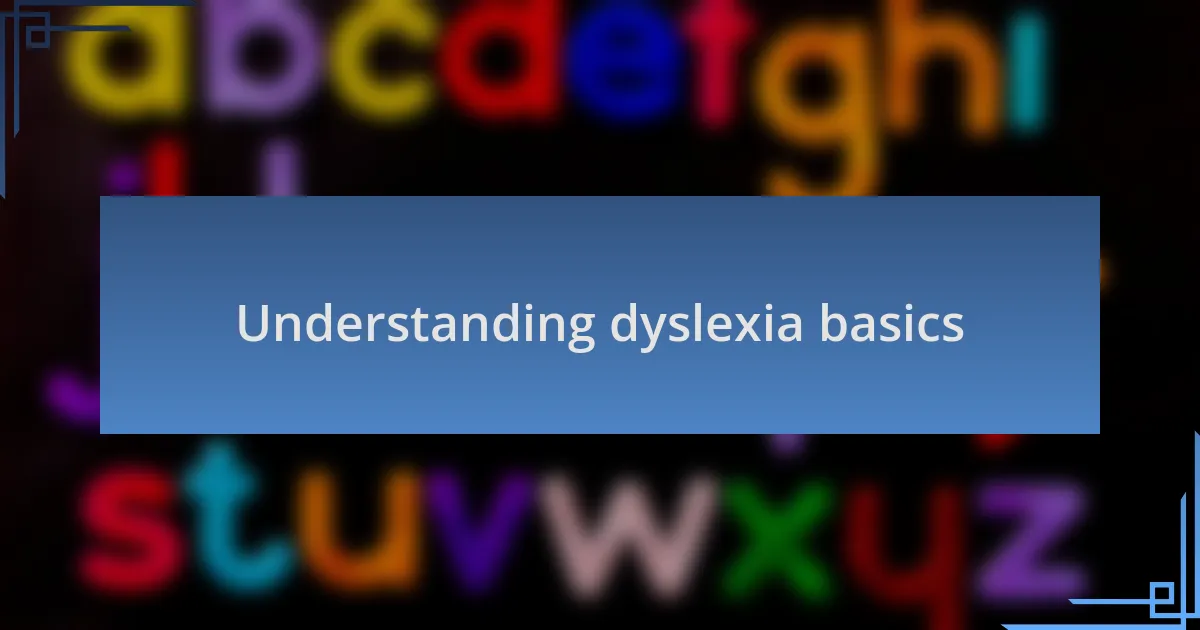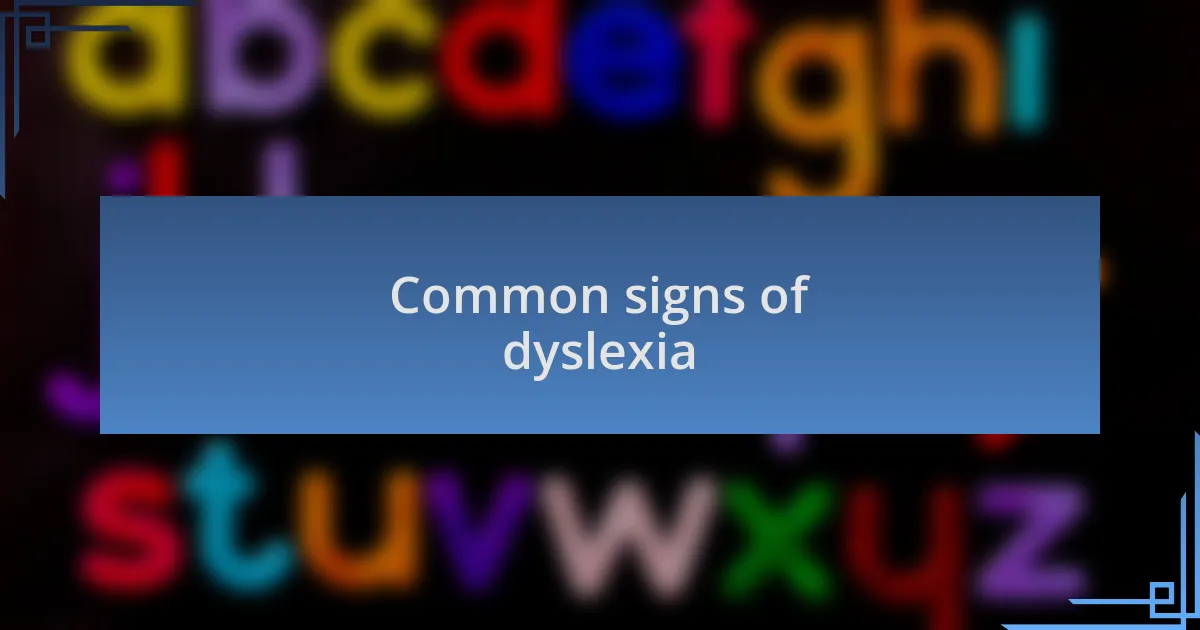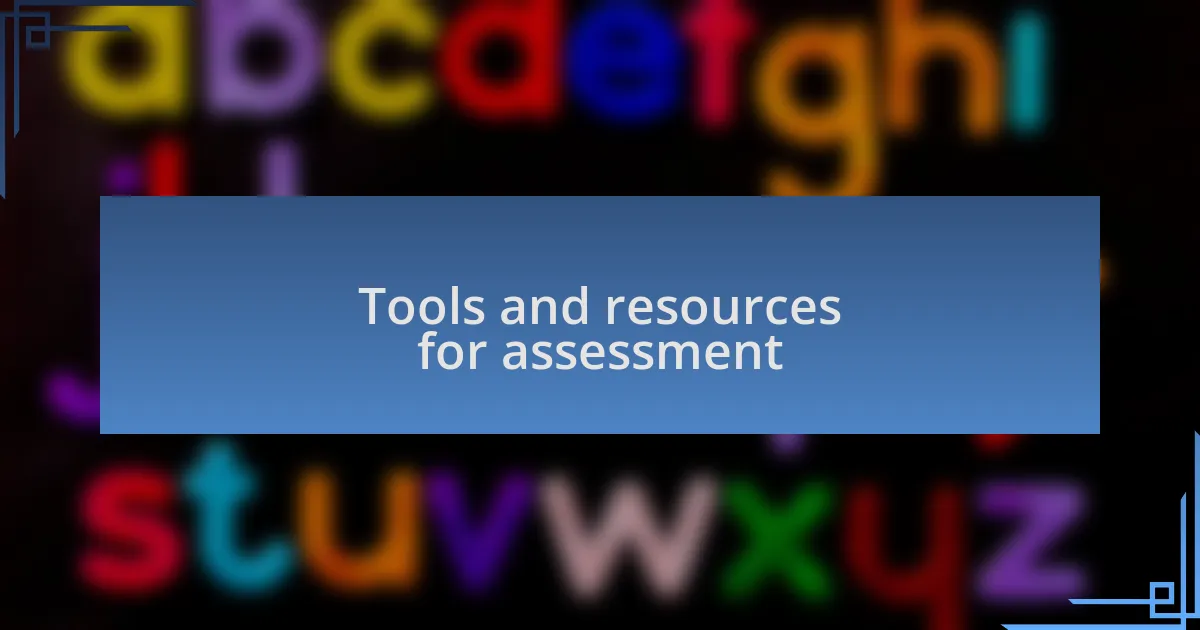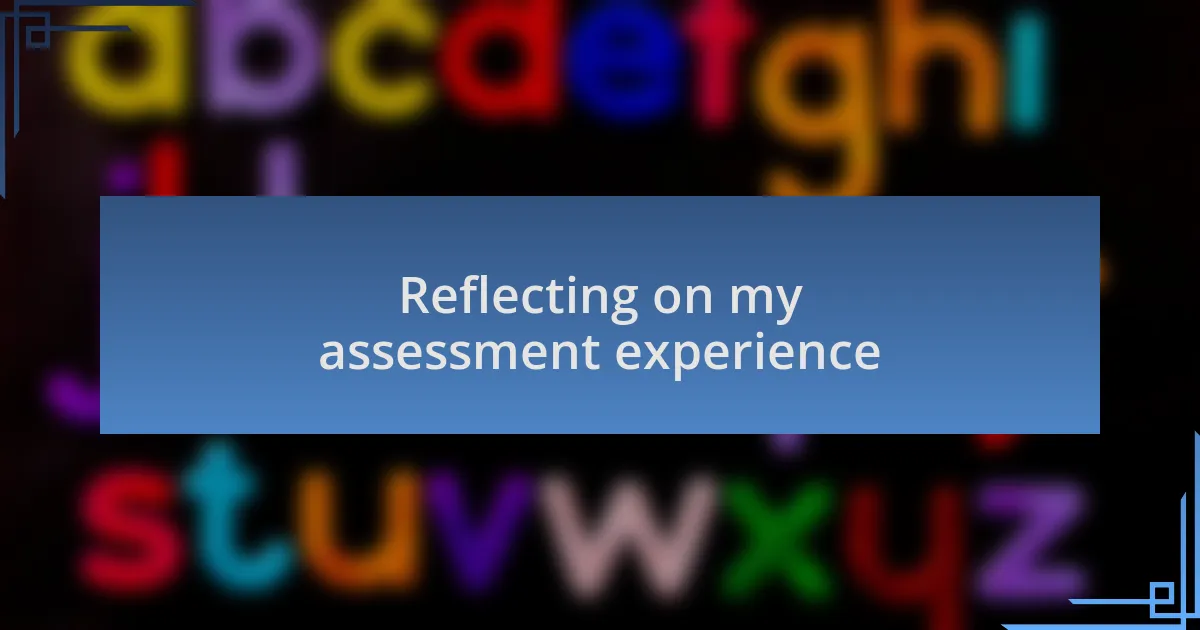Key takeaways:
- Dyslexia is a complex condition that affects reading and writing, but individuals with dyslexia often excel in problem-solving and creativity.
- Training for dyslexia is essential for educators to understand the challenges faced by students and foster an inclusive classroom environment.
- Recognizing common signs of dyslexia, such as phonemic awareness difficulties and variable reading skills, allows for early intervention and support.
- Utilizing a combination of assessments, including strengths-based evaluations and student self-assessments, can effectively identify individual learning needs and enhance educational strategies.

Understanding dyslexia basics
Dyslexia is often misunderstood as simply a reading difficulty, but it’s so much more complex. I remember the first time I worked with a student who had dyslexia; they were brilliant but struggled with traditional reading methods. It struck me how much more was at play—a unique way of processing language that didn’t align with conventional learning paths.
This condition can manifest in various ways, from trouble recognizing words to difficulty with spelling and writing. Questions like, “Why do they struggle with something that seems so simple?” often arise in discussions about dyslexia. From my experience, it’s essential to remember that individuals with dyslexia can thrive in other areas, such as problem-solving and creativity, which highlights their diverse strengths and talents.
Understanding dyslexia also means recognizing its emotional impact. I’ve seen students feel defeated and frustrated, often labeling themselves as “not smart.” That emotional weight is something we must take seriously. By fostering a supportive environment where they can explore their learning styles, we open up opportunities for them to flourish. It’s time to shift our perspective and celebrate the different ways brains can work!

Importance of dyslexia training
Training for dyslexia is crucial, as it equips educators and caregivers with the tools they need to recognize and address the unique challenges faced by individuals with this condition. I recall attending a dyslexia workshop where a trainer shared real-life strategies that transformed the way I approached teaching. Suddenly, I felt empowered, realizing that I could make a significant difference in my students’ lives.
Moreover, dyslexia training fosters empathy and understanding among peers. When I facilitated group discussions about dyslexia, I noticed how fellow educators began to see students not just as struggling learners, but as vibrant individuals with talents waiting to be uncovered. Isn’t it inspiring to envision a classroom that champions diversity in learning styles, encouraging all students to shine?
Finally, the ongoing education and support that come from dyslexia training create a community of practice. I’ve found that connecting with others in this field has provided me not only with knowledge but also with a sense of belonging. It reminds me that we are all in this together, striving to empower those with dyslexia to thrive academically and emotionally.

Common signs of dyslexia
Recognizing the common signs of dyslexia in individuals can be the first step towards providing the support they need. I’ve often observed that one of the earliest indicators is difficulty with phonemic awareness—the ability to hear and manipulate sounds in words. This became evident when a student of mine struggled to sound out “cat” and “bat,” often confusing the sounds. Have you ever seen a child become frustrated when their peers grasp simple words easily? It’s a heart-wrenching sight; these moments highlight the importance of early intervention.
Another sign that frequently stands out to me is the inconsistency in reading skills. I remember working with a learner who could read certain words fluently one day, but struggled with them the next. This inconsistency not only affects their confidence but also their willingness to participate in class. Isn’t it fascinating how emotions play such a critical role in learning? Each moment of hesitation or misreading can be a blow to their self-esteem, making it vital for us to respond with understanding and support.
Moreover, many individuals with dyslexia may struggle with spelling or writing tasks, often resulting in poor grammar and punctuation. I once worked with a student who poured their heart into a creative writing assignment, only to feel disheartened when their words were peppered with misspellings. It made me realize how crucial it is to celebrate the effort rather than just the end result. What if we reframed how we view these challenges, focusing more on the strengths and creativity that each individual brings to the table?

Effective assessment methods
Effective assessment methods can truly illuminate the unique learning pathways of individuals with dyslexia. One approach I’ve found effective is using a combination of formal and informal assessments. For instance, I once utilized a reading fluency test alongside observations during classroom activities. The contrast between measured scores and real-time performance gave me a fuller picture of my student’s abilities. Have you ever seen standardized tests fail to capture a child’s true potential?
Another method that resonates with me is the use of strengths-based assessments. By focusing on what a student excels at, I can create a supportive environment that fosters confidence. I remember assessing a student who struggled with decoding but thrived in oral storytelling. By highlighting their narrative skills, I developed tailored strategies that turned their reading challenges into opportunities for growth. Isn’t it empowering to see how shifting focus can transform a student’s perspective?
Finally, incorporating student self-assessments can be a game-changer. I’ve had learners fill out simple questionnaires about their feelings towards reading tasks, and the insights were enlightening. One student shared their fear of being wrong, which helped me connect on a more personal level. This created a bridge where we could address their anxieties head-on and develop coping strategies. How often do we overlook the power of a student’s voice in their own evaluation?

Tools and resources for assessment
Tools like the Comprehensive Test of Phonological Processing (CTOPP) work wonderfully in dyslexia assessments. I remember administering it to a fifth grader who struggled with spelling. The results clearly highlighted her difficulties with phonemic awareness. This spurred a thoughtful discussion on phonics strategies, allowing us to carve out a targeted intervention plan. Have you ever wondered how a single tool can unlock insights that lead to powerful changes?
Another invaluable resource is the use of observation checklists. I once created a checklist tailored for a child in my classroom, focusing on their reading habits and classroom engagement. Not only did it help me identify patterns in their behavior, but it also made it easy to track improvements over time. Isn’t it striking how something as simple as a checklist can visually reflect a child’s progress?
Lastly, I find that leveraging digital tools can enhance assessments significantly. Programs like Learning Ally offer audiobooks that engage students who may struggle with traditional texts. I once used this resource with a reluctant reader, and it ignited a newfound love for storytelling. How rewarding it is to witness a child’s confidence bloom when the right resources are placed in their hands!

Personal strategies for assessment
To effectively assess dyslexia, I often implement informal reading assessments that allow me to see students in action. A memorable instance was when I had a student read aloud a short passage. Observing their struggles with word decoding made me realize the importance of context—understanding that it’s not just about the words, but about their interaction with the text. Have you seen how a few minutes of shared reading can reveal so much?
Pairing assessments with one-on-one interviews can also provide an intimate glimpse into a learner’s experience. I once sat down with a high school student who openly shared their frustrations about reading assignments. Listening to their thoughts not only deepened my understanding of their challenges but also empowered them to express their needs. How often does a simple conversation open doors to targeted support strategies?
Involving parents in the assessment process has proven invaluable in my practice. After discussing their observations and insights, I found one parent who noticed her child thrived in a non-traditional learning environment. This perspective shifted our approach drastically. It’s amazing how collaboration can lead to tailored strategies that truly resonate with a child’s learning journey.

Reflecting on my assessment experience
Reflecting on my assessment experience often brings to mind a particular session that left a lasting impact. I remember assessing a younger student who seemed to fidget during traditional testing. When I switched to a more interactive method, like using visual aids, the relief on their face was palpable. This moment made me wonder: have we been too rigid in our assessment approaches, overlooking the potential of creativity in learning?
Another memorable experience was when I conducted a group assessment. Watching peers support each other was enlightening. I realized how much their camaraderie alleviated anxiety and fostered a sense of belonging. It’s humbling to acknowledge that sometimes the best assessments happen not when I’m evaluating, but when the students are learning from each other.
I also find that my emotional reactions during assessments can guide my understanding. Once, I noticed an older student’s eyes tear up while discussing their reading difficulties. That vulnerability made me reconsider our strategies and brought an urgency to finding the right support. It prompts me to ask: how can we create a safe space for students to openly share their struggles without fear of judgment?